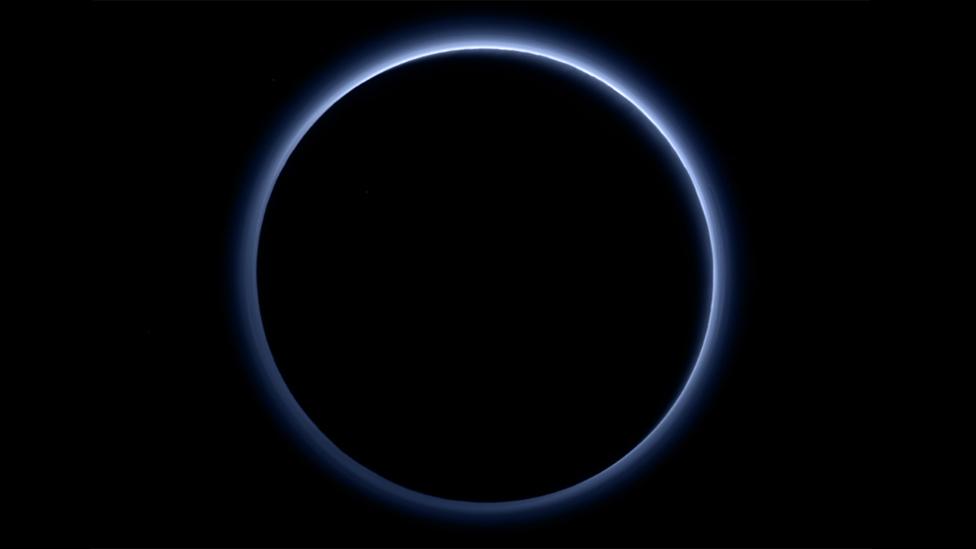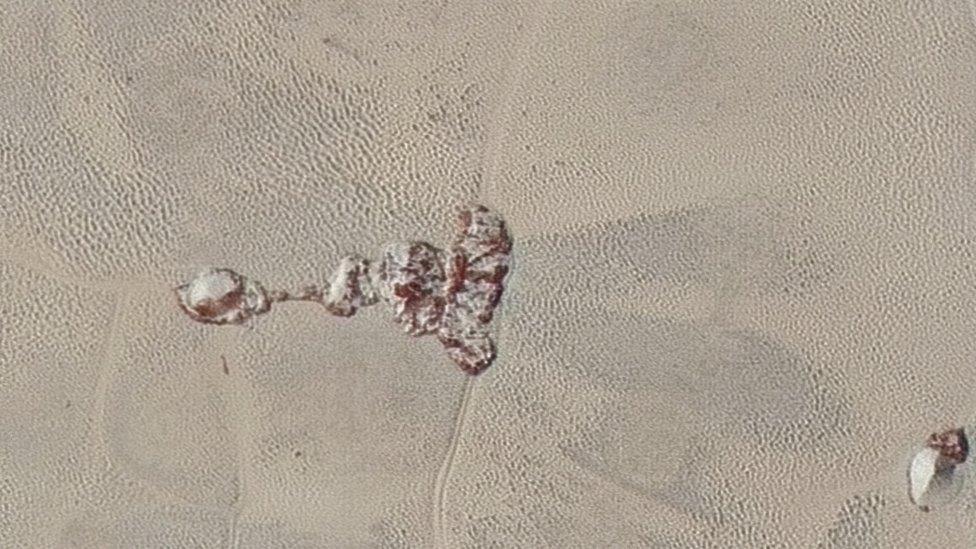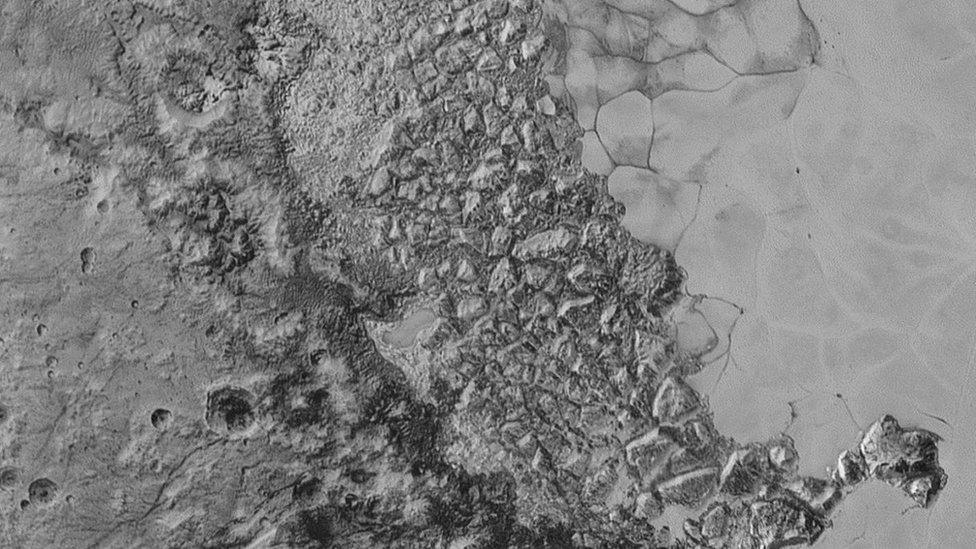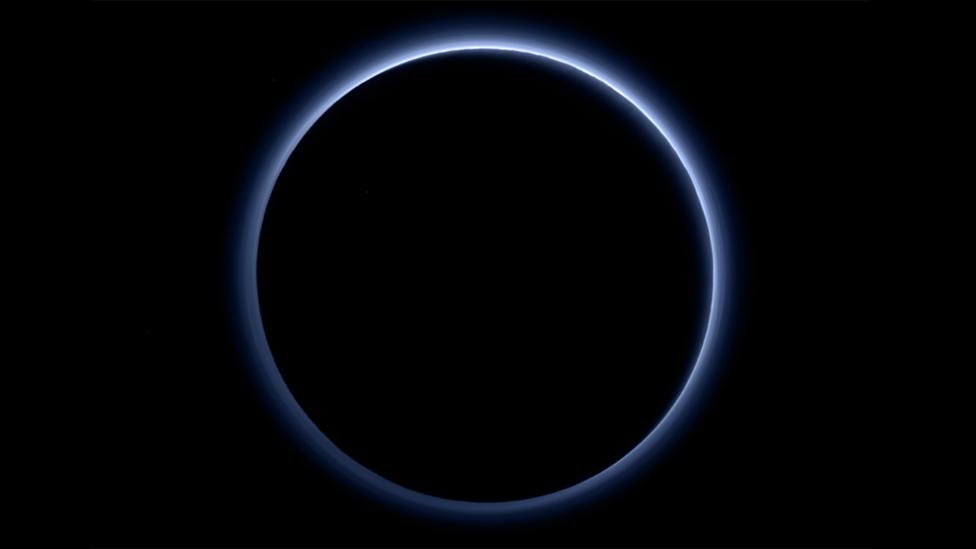Pluto among the 'most diverse worlds' in our Solar System
- Published

The latest pictures of Pluto show it to have a beautiful blue-tinged atmosphere. And analysis of the scientific data sent back by the New Horizons spacecraft so far indicates that it has one of the most diverse landscapes in the Solar System.
To date, Nasa's New Horizons probe has sent back just a tenth of the data it collected as it flew past the Pluto system on 14 July.
The information reveals a surprisingly varied terrain: mountains, dunes, cratered areas and ones that are smooth. The head of the mission, Prof Alan Stern, told BBC News that what he has seen so far is "amazing" and has already transformed our notions of the far-flung world:
"The Pluto system is much more complex than I had expected. Pluto itself displays (such a diverse) range of geological landforms that it is unprecedented in the Solar System," he explained.
"It certainly rivals the Earth and Mars, perhaps even occupies the number one spot for complexity of all the planets in the Solar System."
So what are the discoveries so far?
A thicker atmosphere in the past
A colour image from New Horizons shows that Pluto has atmospheric hazes that have a blue tinge. The startling view is caused by weak sunlight scattering off soot-like particles called tholins in the dwarf planet's thin, nitrogen atmosphere.
Prof Alan Fitzsimmons of Queens University in Belfast says that the initial data suggests the atmosphere may have been thicker in the past.

The sharpest images of Pluto's diverse landscape: A textured plain surrounds two isolated ice mountains
"Perhaps Pluto did have a thicker atmosphere and its atmosphere probably does significantly change once in its orbit," he said.
"Right now, Pluto is receding from the Sun, having been closer to it a few years ago - and it has been speculated that at some point as it moves out to the furthest point from the Sun, the atmosphere and planet may get so cold that the atmosphere may actually collapse on to the surface and freeze out only to be regenerated again as it approaches the Sun."
That theory is borne out by the observation of dunes on the surface not unlike those in the deserts of Earth. If these were made by the action of wind, it implies there might once have been a thicker atmosphere.
Pluto may be active
There is a large area named Sputnik Planum hundreds of miles across that is devoid of craters. That means that something is happening to smooth over the holes left by impacts.

The smooth area to the right is devoid of craters. Could it be due to recent geological activity?
"If that is the case, it is really perplexing because, as a small planet, geophysicists would have expected that it should have cooled off long ago and not have present day activity - yet it does," Prof Stern says.
However, in the equatorial region, there are lots of old, large, craters where other objects have struck over the history of the Solar System. The question is why the terrain is so diverse. Prof Stern doesn't have the answer - at least not yet.
"My head hurts looking at the data," he confesses.
"The flyby continues and the data comes down every week, and we continue to get data and we continue to get surprises and it just gets better and better and it gets more and more perplexing."
How the heart was formed
That is going to be one of the outstanding questions that scientists are going to look at over the coming months and years. It is thought to be made up of fresh, relatively recent deposits of nitrogen ice. But why are other areas not like this?
There are also differences in the composition of the nitrogen ice between the left and right lobes of the "heart".

Planet with a heart: How the feature was formed is one of the big questions raised by the mission, but there are some early ideas
One theory is that there are two geysers at the centre of each lobe that shoot material up above the surface which is then blown by a light wind into the heart shape as it comes back to the surface.
Pluto's size
Pluto was stripped of its status as a planet in 2006 after the discovery of similar objects in the Kuiper Belt region of the outer Solar System - notably the dwarf planet Eris, which was in many ways like Pluto.
The New Horizons mission suggested Pluto might be larger than Eris, so a case could be made to reinstate the former planet. Prof Stern has in the past argued for reinstatement - but seems to have grown weary of the discussion.
"From a planetary science point of view, and as an expert in the field, I should tell you planetary scientists consider it as a planet," he told BBC News.
"The fact that astronomers do not is of little concern to me. The astronomers are not experts in the field and what they say doesn't carry very much weight.
"It's the equivalent of asking a divorce lawyer about tax law; its immaterial. The fact that they are studying things in space like black holes and galaxies has no credence with respect to planets, and what they do just doesn't matter to planetary scientists."

The Tartarus Dorsa mountains show intricate but puzzling patterns
But Prof Andrew Coates, who is a planetary scientist at the Mullard Space Science Laboratory at University College London, respectfully disagrees.
"There seemed to be a great feeling of victory that it was a little larger than Eris," he said.
"This would lead people who would like to call Pluto a planet to think 'great'; and I think that bit was over-egged. For me, that's a non-argument. What we are interested in is what this object is like, the science and its relationship to other Kuiper Belt objects, rather than the size.
Prof Coates added: "Pluto was characterised a few years ago as not a classical planet but an ice dwarf object. That is a good classification because we are seeing something that is different to the rest of the objects in the Solar System."
Nitrogen cycle
There appears to be a possible nitrogen cycle through the atmosphere. Initial observations indicate that glaciers are transporting fresh nitrogen from the mountains across the surface, down to the lower plains where the nitrogen may be heated by the Sun and rises back into the atmosphere where it then precipitates on to the mountains again.

This composite of enhanced colour images of Pluto and Charon was taken by Nasa's New Horizons spacecraft as it passed through the Pluto system
Scientists speculated before the flyby that there would be evaporation and condensation of nitrogen as the surface warmed and cooled. But most thought it would be a gentle process, and the apparent flows of nitrogen glaciers were a surprise.
"If that actually holds up - that is an absolutely fantastic thing," says Prof Fitzsimmons. "No-one had really predicted this."
What's next
The New Horizons spacecraft will send back higher resolution images, which will show exquisite new details of a world that is more beautiful than anyone had ever imagined.
There will also be new information about Pluto's moons. We have received only a glimpse of its largest moon, Charon, but it is a breathtaking one. It is a third the size of Pluto and yet the pictures shows canyons that are several kilometres deep and some signs of geological activity.

Pluto's largest moon Charon has canyons that are several kilometres deep
In just a few months, our knowledge of Pluto has already been transformed. And, according to Prof Coates, there is much more to come.
"The data from New Horizons is rewriting the text books about the outer Solar System. It is a real voyage of exploration to look at this mini solar system of Pluto and its moons."
Follow Pallab on Twitter, external
- Published9 July 2015

- Published8 October 2015
